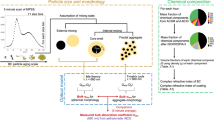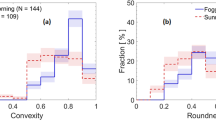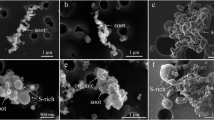Abstract
IT is now recognized that the sooty fraction of the smoke produced by fires in the wake of a nuclear exchange is a critical factor in determining climatic effects1–3. Sooty smoke particles occur as chained aggregates of small spherules which are fractal with a dimension of 1.7–1.9. According to a recently developed mean-field theory4 for the optics of such fractal clusters, their short-wavelength absorption and scattering characteristics should differ fundamentally from those of spheres. Here I present the results of simulations of scattering from computer-generated fractal clusters which confirm that the theory is appropriate to fractal soot. The theory indicates that soot absorptivity is insensitive to particle size and hence that coagulation in a soot aerosol affects only slightly its optical depth. Studies of the climate effects of nuclear war that model sooty smoke as coalescing spheres are therefore likely to underestimate the severity of 'nuclear winter'.
This is a preview of subscription content, access via your institution
Access options
Subscribe to this journal
Receive 51 print issues and online access
$199.00 per year
only $3.90 per issue
Buy this article
- Purchase on Springer Link
- Instant access to full article PDF
Prices may be subject to local taxes which are calculated during checkout
Similar content being viewed by others
References
Schneider, S. H. & Thompson, S. L. Nature 333, 221–227 (1988).
Turco, R. P. & Golitsyn, G. S. Environment 30(5), 8–16 (1988).
Ghan, S. J. et al. J. geophys. Res. 93, 8315–8337 (1988).
Berry, M. V. & Percival I. C. Optica Acta 33, 571–589 (1986).
Penner, J. E. Nature 324, 222–226 (1986).
Radke, L. F. et al. in Proc. Third WMO Scientific Conf. on Weather Modification, World Meteorological Organisation, Geneva, 119–126 (1980).
Thompson, S. L. et al. J. geophys. Res. 92, 10942–10960 (1987).
Penner, J. E. & Porch, W. M. Atmos. Envir. 21, 957–969 (1987).
Mandelbrot, B. B. The Fractal Geometry of Nature (Freeman Co., New York, 1982).
Samson, R. J. et al. Langmuir 3, 272–281 (1987).
Nelson, J. A., Crookes, R. J. & Simons, S. J. Phys. D (submitted).
Meakin, P. Phys. Rev. A27, 1495–1507 (1983).
Botet, R. et al. J. Phys. A 17, L75–L79 (1984).
Nelson, J. J. mod. Opt. (in the press).
World Climate Programme report WCP-55: Report of the Experts' Meeting on Aerosols and their Climatic Effects (eds Deepak, A. & Gerber, H. E.) (1983).
Weitz, D. A. et al. in Scaling Phenomena in Disordered Systems (eds Pynn, R. & Skeltorp, A.), 171–188 (Plenum, New York, 1985).
Hallet, J., Hudson, J. G. & Rogers, C. F. Aerosol Sci. Technol. 10, 70–83 (1989).
Berry, M. V. Physica D (submitted).
Author information
Authors and Affiliations
Rights and permissions
About this article
Cite this article
Nelson, J. Fractality of sooty smoke: implications for the severity of nuclear winter. Nature 339, 611–613 (1989). https://doi.org/10.1038/339611a0
Received:
Accepted:
Issue Date:
DOI: https://doi.org/10.1038/339611a0
This article is cited by
-
Fractal morphology, imaging and mass spectrometry of single aerosol particles in flight
Nature (2012)
-
Radiation of some fractal structures
International Journal of Theoretical Physics (1993)
Comments
By submitting a comment you agree to abide by our Terms and Community Guidelines. If you find something abusive or that does not comply with our terms or guidelines please flag it as inappropriate.



